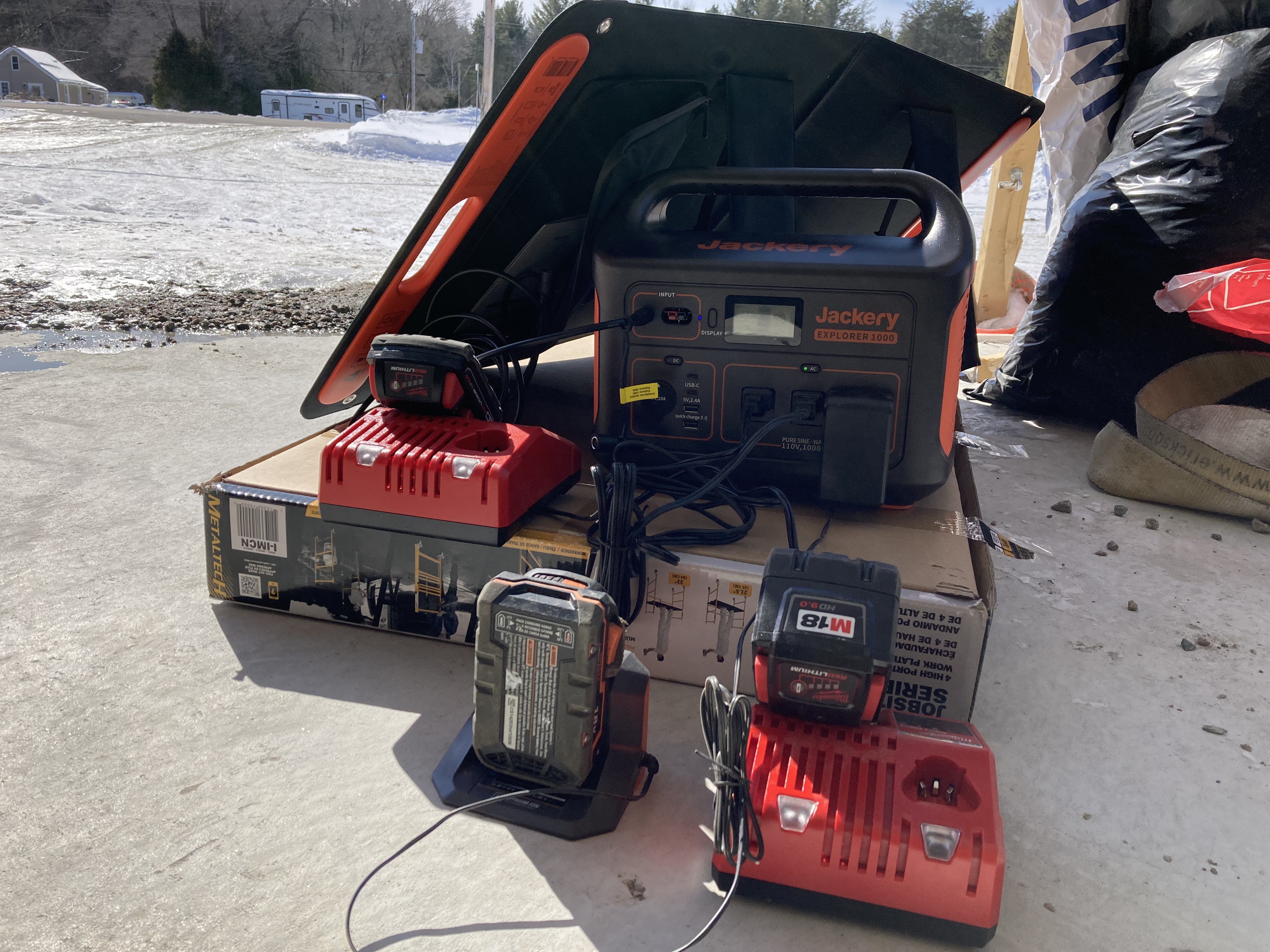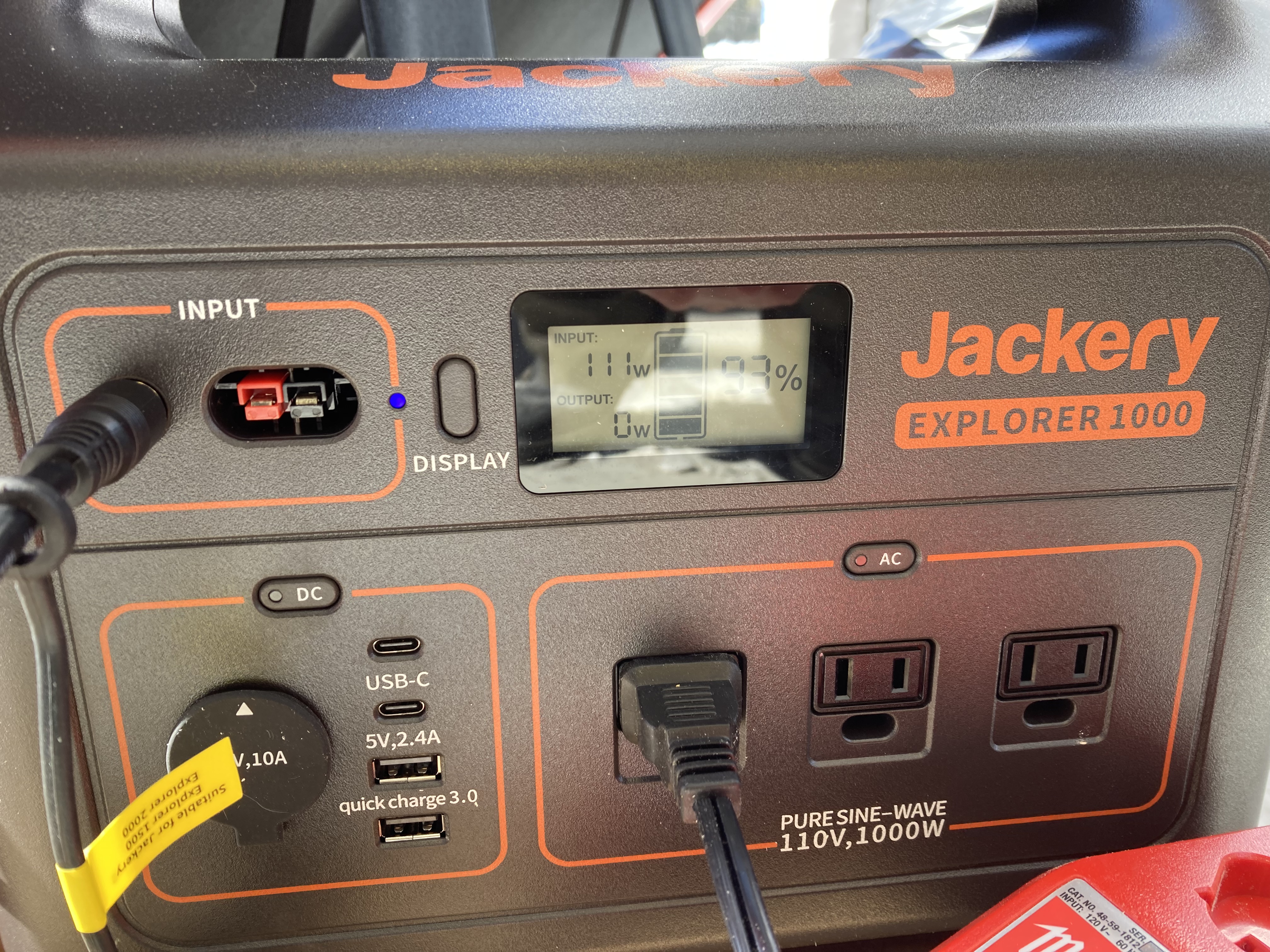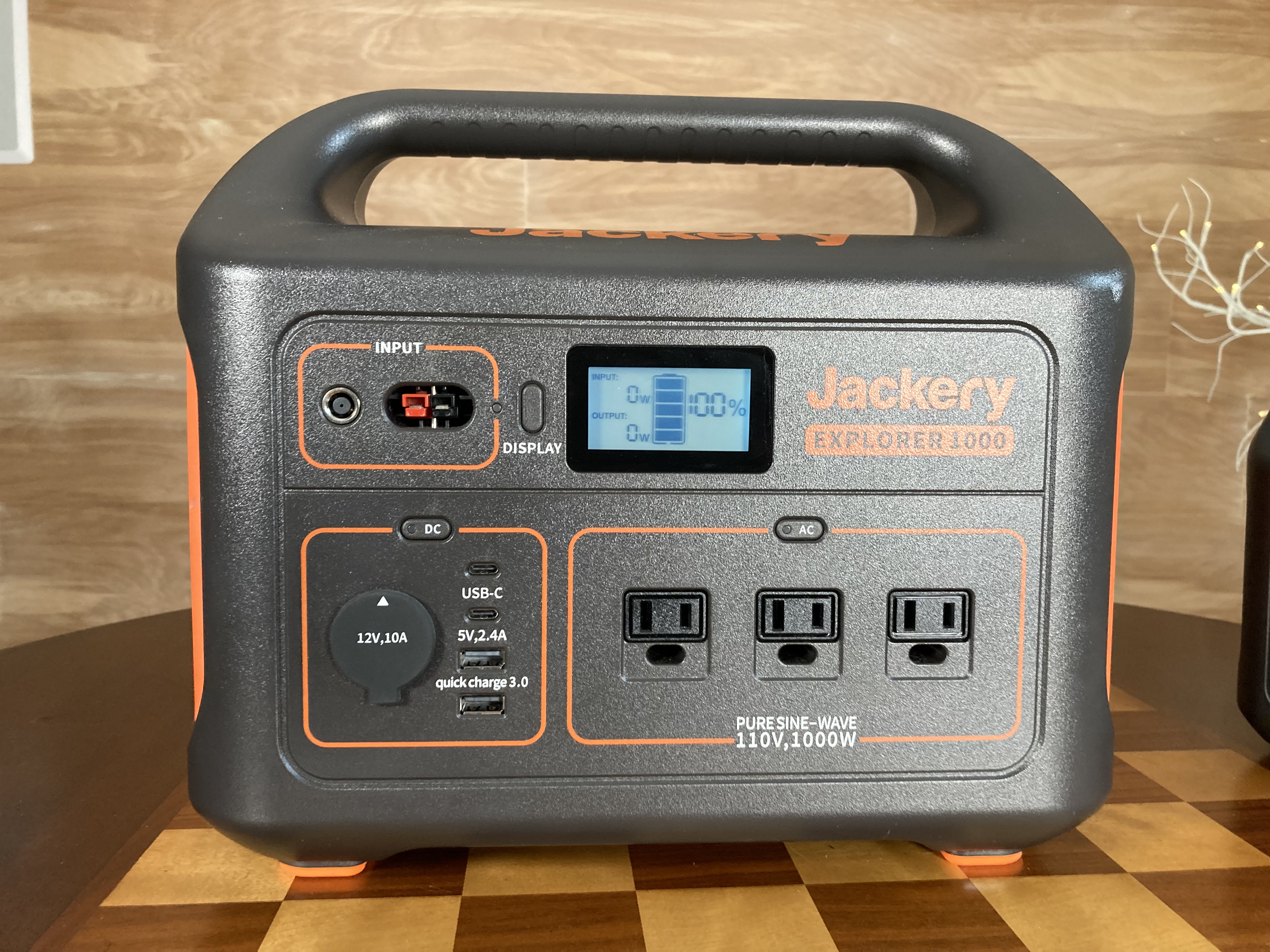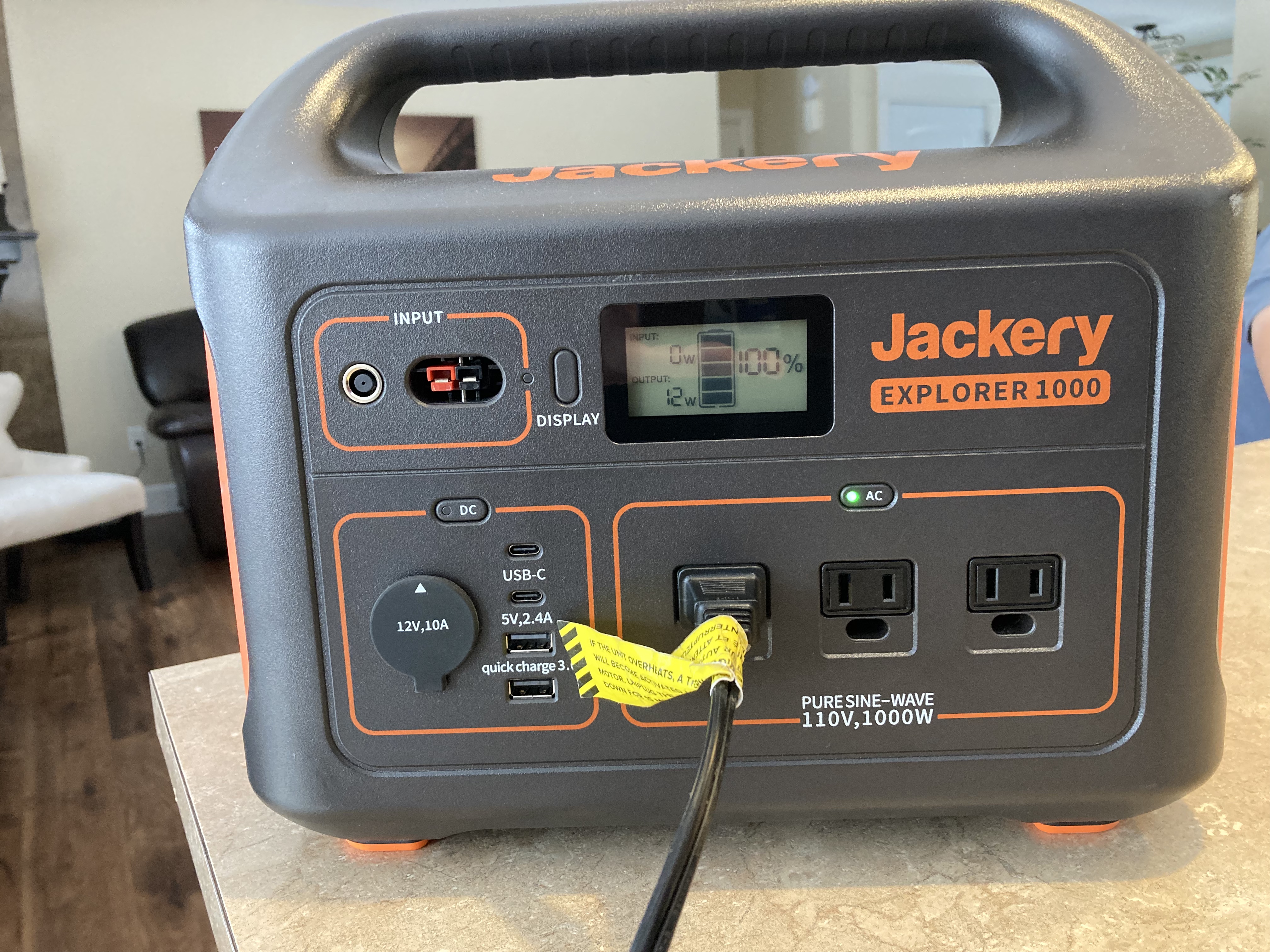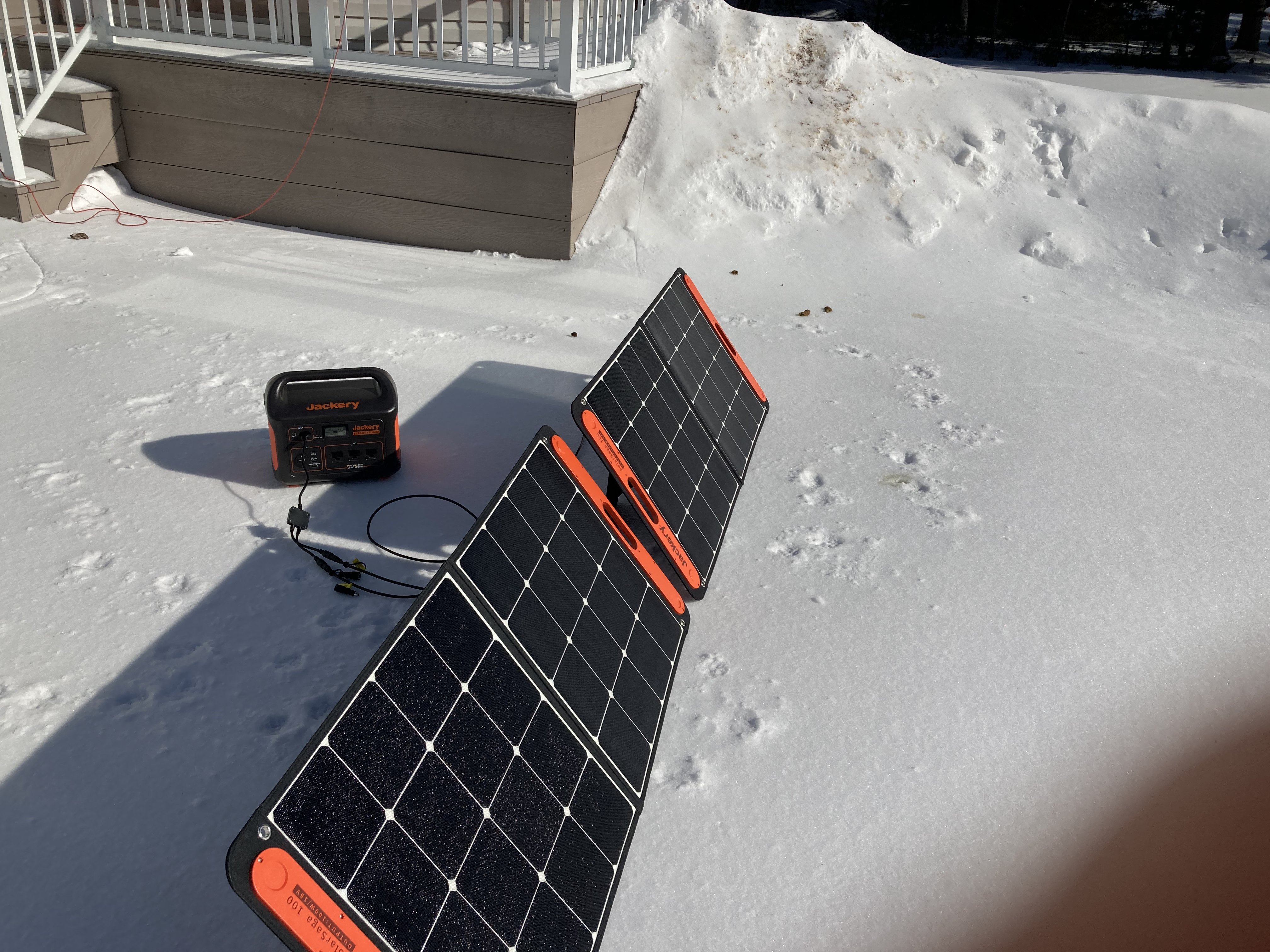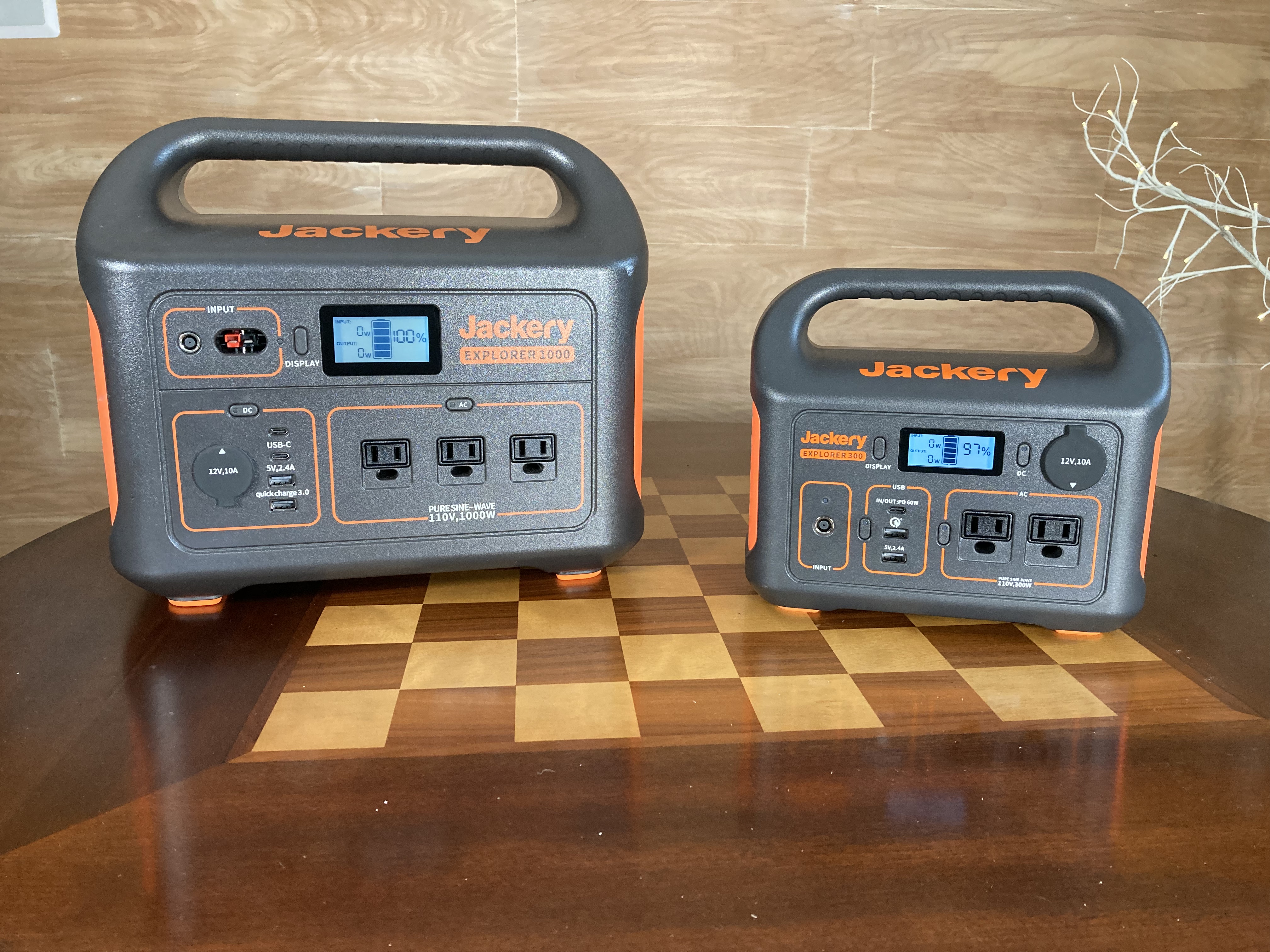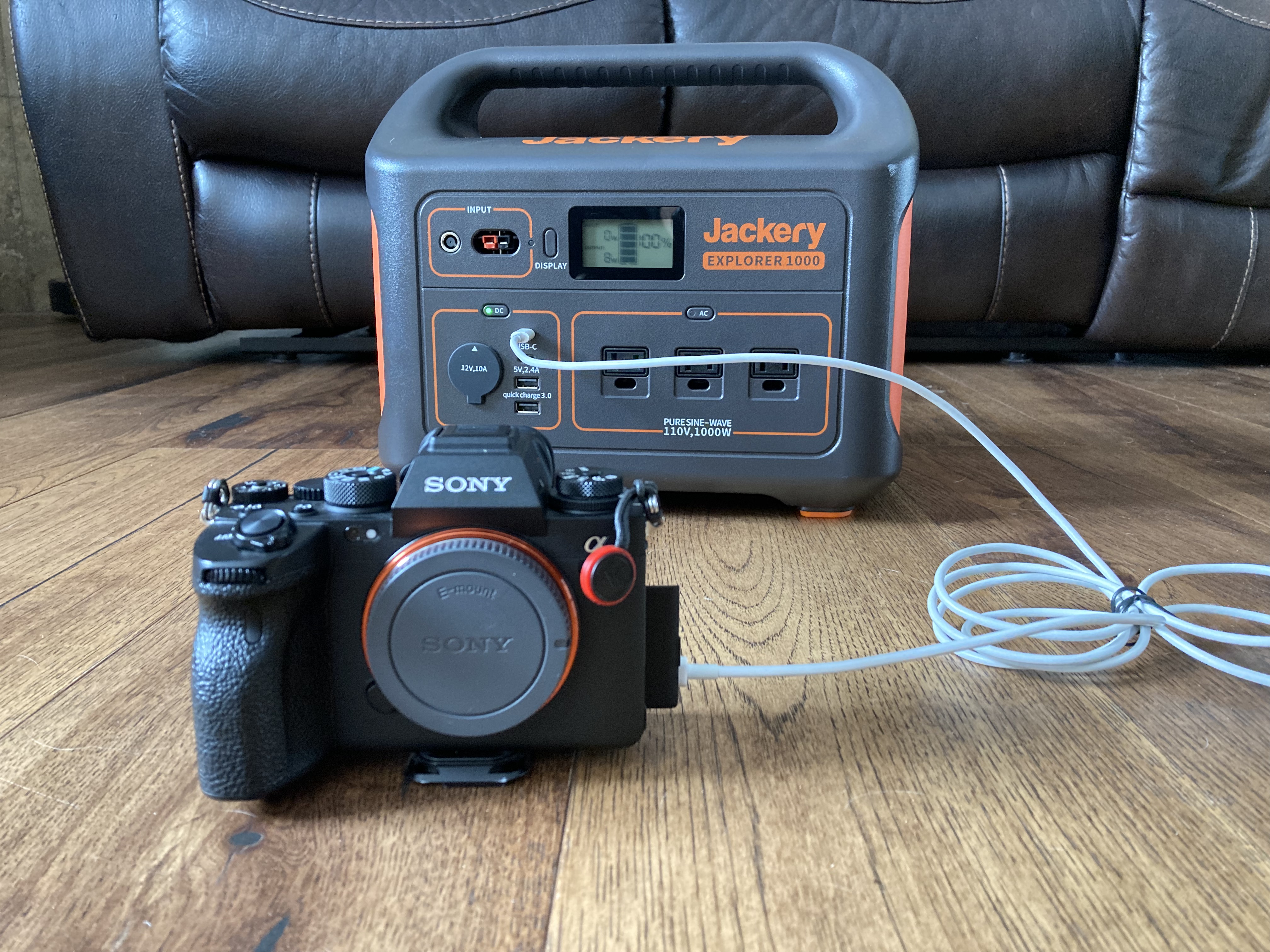Several months ago I took a chance on Jackery, a company that specializes in remote power options like powerful battery systems and portable solar panels, and reviewed their Explorer 300 and SolarSaga 100 (solar panel) combination. I was very impressed with the build and execution of the package, and I’ve taken to frequently charging my camera batteries directly from the solar panel mostly for the joy of being able to recharge those batteries for “free”. It’s a rewarding feeling to get back that power “off grid”.
At the time of that review I expressed my desire to look at one of their bigger units in the future. Those larger units are a more serious option for power outages, camping, and running a wider range of devices. I’ve now had an opportunity to spend some time with the Explorer 1000 unit as a short term option to address the power outages that happen periodically at my house and leave me not only without power for lights, heat, or refrigeration, but also without internet, telephone (cable connection), and running water. These larger units (Explorer 1000 or 1500) are not true “whole house” solutions, but do have enough power output to solve my communication and running water problems for a day or two and thus make those downtimes far more palatable…and could provide some heat in a pinch too. The Explorer 1000 also seems to be a great portable power solution for those thinking about the upcoming camping season.
I’ve found that there are a lot of places where a larger power source like this comes in handy, and there’s a reason why this particular unit has page after page of 5 star reviews. Speaking of those reviews: it seems like a very common application for the Explorer 1000 is for campers who need to run a CPAP machine “in the wild”. Many people have been delighted to find that they could go a 4 or 5 day camping trip and power their CPAP that whole time (even better if you can use solar panels to recharge!).
While there are obviously a lot of design similarities between the Explorer 1000 and its little brother that I reviewed several months ago, there are also some unique features that stood out to me during my review period. First of all, the Explorer 1000 has the ability to receive power from two SolarSaga 100 panels at the same time via an adapter cable.
It obviously takes longer to charge as it has a much larger battery, but the ability to attach two solar panels can accelerate that process. Two SolarSaga panels can (under optimal conditions) take the state of battery charge from 0-80% in about 6.5 hours, or only an hour longer than the 5.5 hours it takes to achieve a similar charge from a wall outlet using the included power brick (which is larger than the one for the Explorer 300).
What was interesting, though, is that I found the Explorer 1000 to be more efficient in processing power even for a single SolarSaga panel. I saw higher figures when using a single panel in optimal conditions than I’ve ever seen with the Explorer 300. When I put the two units side by side with a panel attached to each (in less than optimal conditions, a partly cloudy day), I consistently saw the Explorer 1000 register a few extra watts of charge relative to the Explorer 300.
I took the Explorer 1000 to my jobsite and plugged in a number of chargers for my power tools to it. At one point I was charging three separate battery packs using three different chargers.
I was very impressed by two things: 1) I saw figures as high as 114W (registered) of input into the Explorer 1000 from a single panel (the winter sun was extremely bright that day) and 2) I charged all of my batteries while also increasing the state of charge from of the unit from about 80% to 100% within a few hours. This is a really interesting application for the Explorer 1000. If you work on remote job sites without power, you could easily charge your batteries for your power tools, and, with a SolarSaga or two, you might be able to do it without ever using AC power. You could even run some smaller tools off the Explorer (think jigsaw, not chop saw).
Build and Features
I’ve been using Jackery products for about four months thus far, and I’ve been consistently impressed with the quality of the build and the toughness of the materials. The casing is largely engineered plastics, but with rounded edges that won’t knock on things or scuff easily. I noted positive design elements like large, rubberized feet on the bottom of the Explorer 1000 that will keep it from banging on surfaces, large hex screw heads, and cleverly designed magnetic clasps on the solar panel that allow it to fold up instantly without any need for additional steps with clasps. The carrying handles were comfortable and the layout was clear and instantly easy to use. It’s often those little details that really make the difference in the “joy” of using a product.
Another interesting addition to the Explorer 1000 that was lacking on the 300 is a built in LED light on the upper left side of the unit. This is very helpful when trying to get something set up in the dark or even in just moving the Explorer to the proper spot (say while setting up camp).
The front of the Explorer 1000 is cleanly laid out with clear labelling for the various ports where power flows either in or out of the unit. There is small LCD screen with a quality readout (and which can be backlit by pressing the “Display” button next to it). It gives a fairly accurate readout of power remaining (to a percentage point), and, interestingly, also reads out both the power flowing in and/or the power flowing out. I find this interesting in both directions, as while the power coming in from a standard source (like AC power) is a constant, the power from a source like solar panels is going to vary widely depending on the conditions, and this can give you real time feedback for how to best position your solar panel(s) for maximum efficiency.
The Explorer 1000 expands the ways that you can distribute the power it holds over the Explorer 300 I previously reviewed. Instead of 2 AC outlets, we now have 3 AC outlets that can output 110V, 1000W pure sine-wave power (nice and clean). As noted, this is further helped by being able to cover surge power draws of up to 2000W, which dramatically increases the amount of things one can power from the AC outlet.
On the DC front, there is a 12V, 10A car outlet that can power a variety of things that take the standard car plug. There are now a total of four different USB based ports, with an additional USB-C port (with the PD standard) in addition to the 5V, 2.4A USB 2.0 port and a quick charge USB 3.0 port. In short, you can have a lot of things plugged into the Explorer 1000 at the same time! Here’s a look at a chart that details the various outputs:
There are three different ways to charge the Explorer 1000. The first is the aforementioned AC adapter, which is included in the kit. You can charge from zero to 100% in 7 hours with the AC adapter. Secondly, you do have the option of charging from a 12V source (i.e. a “cigarette lighter” in a vehicle), and the charging adapter for that is included as well (expect about 14 hours to fully charge with this). Connecting a SolarSaga panel or two is the third way to recharge the battery in the Explorer 1000 (you can charge to 100% in 8 hours under good conditions with two panels). Unlike the Explorer 300, however, you cannot charge the bigger Explorer 1000 by using the PD USB port to receive power. I also tested the charging brick from the Explorer 300 and found that it could not be used to charge the bigger unit; you need to use the larger power brick included with the Explorer 1000.
While conditions continue to be less than idea for solar charging around here (winter hasn’t quite departed), longer days makes for better charging. I’ve been able to get reasonable amounts of power even indoor through windows (roughly 60W), and, outdoors, I’ve seen figures of 130+ watts, which allows for a reasonable recharge rate even of the bigger battery. The high figure I’ve seen with a single panel in optimal conditions gives me hope for strong charging figures in those conditions.
The Explorer 1000 is considerably larger and heavier than its little brother that I previously tested. It weighs in at a heftier 22 pounds (about 10kg) vs 7.1lbs (3.2kg). It’s dimensions are 13.1 x 9.2 x 11.1 in (33.3 x 23.3 x 28.3 cm). The shape and well executed carrying handle makes it still nicely portable, however.
Testing the Explorer 1000 and SolarSaga 100
My tests included some of the same type tests I did on the Explorer 300 (to establish a baseline of performance) along with some fresh tests to check out the higher limits of the Explorer 1000.
First, I wanted to compare the results with the Explorer 1000 in a test I used for the Explorer 300. I had wanted to test the battery life of the Explorer 300 in a photography setting, so I attached the powerful 150W Godox SL-150 II video spotlight to it and turned the spotlight on to 100% output. I started with a 100% charge on the Explorer 300 at 8:57 AM, and monitored it throughout the day. I got roughly 5.5 hours out of powering the light with the Explorer 300. I ran the same test with the Explorer 1000, starting the test at 7:38 PM with a 100% charge. The light showed a draw of 57W. At 8:48 PM the draw showed at 59W and the state of charge was 92%. At 5:27 AM the draw was 58W and the state of charge was 33%. I had to leave for my work day by about 8:30 AM, and didn’t return home until about 5 PM, at which time the battery was 100% drained. Based on the math from these data points, I would expect that I could get between 14 and 15 hours of straight powering of the light…depending on how accurate the power meter on the front of the unit is.
Part of my plans for the Explorer 1000 include powering certain key components at my house during a power outage. These include communications (wireless router) but also my well pump so I don’t lose running water. I haven’t had a power outage during my review period, nor have I had time to rewire my well pump so that I have a plug that I can put into the AC output on the Explorer 1000 to power, so I ran a test with our blender. We use a Ninja Professional blender for our morning fruit and protein smoothies. It boldly proclaims that it is an 1100W unit, but I also know how electric motors work, and that rating is the maximum draw, a surge where the motor initially spins up but then requires far less power once the motor is activated to keep it moving. I suspected the Explorer 1000 could probably handle it…and it did.
There was never a moment’s hesitation. I had my wife blend our smoothie just as she normally would, save the Ninja was plugged into the Explorer instead of a house AC outlet. That meant starting on high for the initial blending/chopping cycle and then a second cycle on a lower setting to blend in the protein. The first cycle showed a very brief surge to 901W of registered draw before settling into a continuous draw in the high 300W/low 400W range. The second cycle had a brief surge at roughly 300W before settling into a continuous draw of about 190W. The Explorer 1000 didn’t break a sweat.
I started with a state of charge at 100%. I ended with a state of charge at 100%. We could blend our smoothies for a month in our normal way without exhausting the battery. That’s pretty cool!
Jackery rates the Explorer 1000 as being able to run a blender at 500W for 2 hours. 2 hours of blending is actually a really long time, particularly when you consider that most of your blending experiences are probably only a minute or two of actual run time. This further confirms my feeling that the E1000 could be a viable short term solution in a power outage situation, and definitely a prime audience in my research are “preppers” who like to be ready in case of emergency. One significant advantage of the Explorer 1000 is that is utterly quiet when in use, produces no exhaust, and holds its state of charge very well so it is always ready to go.
I enjoyed reading the accounts of people who have used the E1000 for camping trips and “boondocking” (a new term for me!) and in what they powered with it on their trips. I’ve already mentioned the popularity of the unit for running CPAPs, but others used it to run refrigerators, Keurigs, microwaves, George Foreman grills, TVs, and more. One user who also purchased the SolarSaga panels in kit mentioned doing a 30 day, 2200 mile trip where the E1000 was essentially their power source for the whole trip for their coffee, cooking, and powering of electronic devices. My experience with charging my power tool batteries on the jobsite tells me that with reasonable conditions for the panels you could have power pretty much indefinitely. I can attest that charging my phone or iPad essentially doesn’t even move the needle in terms of power dissipation. Jackery claims that you can recharge an iPhone 8 100 times!
I noted previously that via an included adapter with the kit, you can attach two panels at the same time to the Explorer 1000 into the ANDERSON input on the front. I tested the efficiency of this connection on a day where conditions were fairly poor for solar charging. I connected the two panels to the Explorer 300 and 1000 to get a register of what the two panels were supplying independently. I registered varying input of about 39-43W. I connected the two panels to the Explorer 1000 with the adapter and immediately saw 84-86W; it essentially was exactly what the panels had been sending independently to the two units before but now combined into a single input. That was encouraging, as it showed that power was not being lost.
The Jackery Explorer units also solve an additional problem as a photographer. Many recent cameras have gone to the PD (Power Delivery) standard requirement for charging batteries in camera, but I’ve been somewhat frustrated by the fact that the standard is not consistent across brands. My Canon EOS R5 won’t charge from the same adapter and cable that my Sony Alpha 1 can charge from, and vice versa. I’ve had to have two different charging setups to accommodate these cameras, which are my main “daily drivers.”
Frustrating.
The Explorers delivers power in such a way that I can charge both cameras from it, however, and while using the exact same USB-C cable. I’ve taken to just charging my cameras from the Explorer when the sun isn’t available and then just charging the Explorer via the SolarSaga. Recharging any of my four cameras is a breeze, even if I’m charging multiple cameras at the same time. Recharging my Sony Alpha 1 from about 20% to 100% only cost me 2% of charge on the Explorer 1000, so it would be very easy to never pay to charge my cameras again by just periodically putting the Explorer 1000 outside with a panel or two to recharge.
Let’s talk about the SolarSaga 100 for a moment. This is a 100W portable panel that weighs in at only about 9 pounds and folds up into a slim, portable package. It is IP65 rated – meaning that it can handle being splashed with water, though they don’t recommend submersing it or using it in heavy rain. I love the rear design, that has two clever kickstands that normally stay laid flat via Velcro but can easily fold out to support the panel at a good angle for catching the sun. Even better is the incorporated pouch on the back that stores the cable that runs to the Explorer unit but also a USB-C(5V,3A) output port and a USB-A(5V, 2.4A) output port that can easily charge 2 small devices directly (phone/tablet + camera, for example). That gives the panel some standalone value, obviously, which could be very useful while camping. There’s a new 100x version which is just a little different cosmetically but is the same functionally.
Jackery has a full lineup of products at various power outputs. The Explorer 1000 seems to hit a sweet spot for many people due to its versatility of what it can power (and for how long!) while still being manageable in size and weight. I’ve found that both the Explorer 300 and Explorer 1000 would serve different needs for me. I love the portability of the Explorer 300, and, for photography, it makes a lot of sense. The Explorer 1000 is less portable, but it also dramatically expands the applications that I can use it for, which is also useful. As always, it boils down to choosing the right tool for the job.
The Explorer 100 has a price point of $1099 USD, or you can also buy it in a kit with one or two SolorSaga panels as a kit and save a few bucks in the Amazon Jackery store. The two solar panel kit offers the most tangible value per component, as you are getting two panels for only $450 (total) over the bare Explorer 1000 unit. There are cheaper options out there, but I feel like the quality and execution of the Jackery products make them a solid value. You can check out my findings and tests in greater detail by watching my video review below or on YouTube.
Follow Me @ Patreon | My Newsletter | Instagram | Facebook | DA Merchandise | Flickr | 500px
Thank you to Jackery for getting me a review sample of the units. As always, this is a completely independent review. The opinions here are completely my own.
Gear Used:
Purchase Jackery Portable Power and Solar Panels @ B&H Photo | Amazon | Amazon Canada | Amazon UK | Amazon Germany
Purchase the Sony Alpha 1 @ Camera Canada | B&H Photo | Amazon | Amazon Canada | Amazon UK | Amazon Germany | Ebay
Buy DA Merchandise https://bit.ly/TWIMerch
Purchase a Sony a7C @ B&H Photo | Amazon | Camera Canada | Amazon Canada | Amazon UK | Amazon Germany | Ebay
Peak Design Leash Strap: Peak Design Store | B&H Photo | Amazon | Amazon Canada | Amazon UK
BenQ SW271 4K Photo Editing Monitor – B&H Photo | Amazon | Amazon.ca | Amazon UK
Adobe Photoshop Creative Cloud 1-Year Subscription
Exposure Software X6 (Use Code “dustinabbott” to get 10% anything and everything)
Visit Dustin’s Amazon Storefront and see his favorite gear
Purchasing your gear through B&H and these links helps fund this website and keeps the articles coming. You can also make a donation here if you would like. Visit my Amazon page for some of my gear of choice! Thank you for your support.
Great News! I can now offer a 5% discount on all purchases at Amplis Foto, Canada’s Leading Photographic Supplier. Please enter discount code: AMPLIS52018DA in your cart. It is good for everything in your cart, and is stackable with other coupons, too! It will take 5% off your entire order! Proceeds go towards keeping this site going and providing you with new reviews!
Check me out on: My Patreon | Sign Up for My Newsletter | Instagram | Facebook | Twitter | Flickr | 500px | Google+ |
Keywords: Jackery, Jackery Explorer, Jackery Explorer 1000, Jackery SolarSaga, SolarSaga 100, Review, Explorer, 300, 500, 1000, 1500, SolarSaga, 60, 100, 300W, 1000W, Demonstration, Test, Photography, Solar Power, Portable, Camping, Hiking, Video Lights, Back up Power


